Titanic Quarter |
|
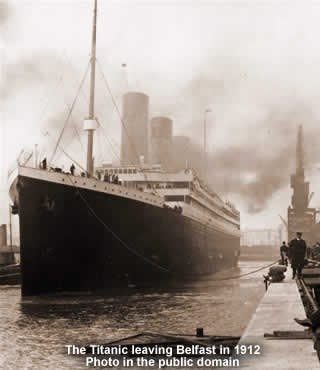 |
|||
An icon for human achievement that became one of the most famous and tragic accidents in history |
|||||||
Listen to this article |
|||||||
|
|||||||
In the spring of 1909, the workers at Belfast's Harland and Wolff shipyard started work on their biggest job yet. The vessel was called "Titanic", and it would be larger than any ship ever built before and demonstrate unrivalled craftsmanship. |
|||||||
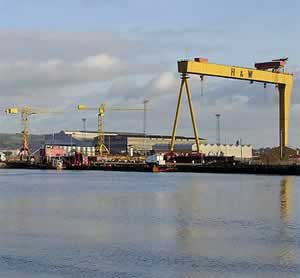 The Harland and Wolff Shipyard Photo rovingI |
|||||||
During the next three years, over 14,000 workers contributed to the project. There was a lot to do; the finished vessel would be 269 metres long, with 9 decks and enough room for 3,547 people. It would include 4 huge smokestacks, a 100-ton rudder and over 3 million rivets. |
|||||||
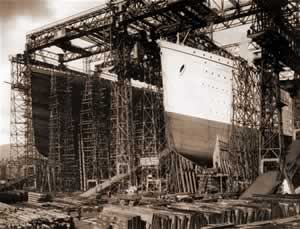 Construction of Titanic in 1910 Photo in the Public Domain |
|||||||
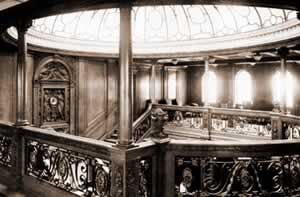 Titanic's Grand Staircase Photo in the Public Domain |
|||||||
|
|||||||
In April, 1912, the Titanic was finally able to leave Belfast under its own power. It sailed to Southampton in preparation for its maiden voyage across the Atlantic Ocean to New York, America. |
|||||||
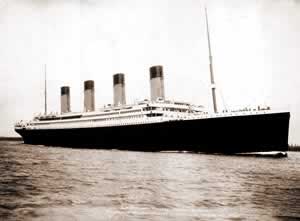 Titanic sailing for New York in 1912 Photo in the Public Domain |
|||||||
It was such a proud and momentous occasion, that the world's media covered it in minute detail. There were 2223 passengers, including famous celebrities and honeymooning couples. The Titanic lived up to its name; it existed on a scale that seemed to defy reality. Mankind could barely believe what it had achieved. Sadly, all of this pride and awe ended several days later, on a calm, starry night in the middle of the Atlantic. The ship brushed past an iceberg, damaging its' starboard side. To the passengers it felt like a brief shudder, and nothing else. Unfortunately, this small accident proved to be much more serious. It turned the world's largest ocean-going vessel into the worst maritime accident in history, with 1517 people losing their lives in the ocean's cold, merciless water. |
|||||||
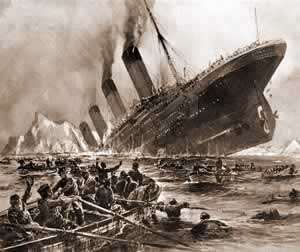 The sinking of Titanic Drawn by Willy Stöwer |
|||||||
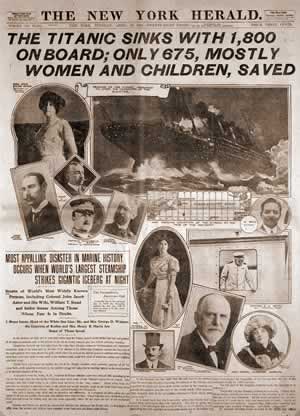 Newspaper headline from the New York Herald announcing the disaster Photo in the Public Domain |
|||||||
|
|||||||
In the years since that day there have been several investigations into why the number of deaths was so tragically high. It was widely believed that such a disaster shouldn't have been possible; that the Titanic was unsinkable. |
|||||||
First, was the fact that there weren't enough life boats for everybody. The ship could have held more, but rumour has it that they made the decks look too cluttered. Even the lifeboats that were used didn't get filled to capacity, because at first nobody appreciated the seriousness of the situation. Secondly, it is believed that the boats lookouts didnt have binoculars. Warnings of icebergs in the area were ignored or lost. After the collision, the Titanic's rocket signals were misunderstood by another nearby craft that could have helped. It's even plausible that if the ship had rammed the iceberg head-on, there would have been less damage. |
|||||||
As the boat slipped beneath the waves, there are countless stories of its brave passengers. There are the stewards who guided people to the lifeboats, the captain who went down with his ship and the band who carried on playing to the very end. |
|||||||
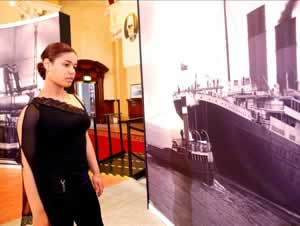 Learning abut the Titanic in the Titanic Exhibition Photo NITB |
|||||||
|
|||||||
The best place to learn more about these stories is in Belfast, the city that brought the Titanic into being. Harland and Wolff are still going, although they haven't built a ship in quite a while. Visitors to the docks can see where the craft was designed, then where it was constructed and launched. In fact, the entire harbour area is the subject of a brand-new development known as the Titanic Quarter. In this way, the city has ensured that one of its greatest achievements, which became one of the ocean's greatest tragedies, will never be forgotten. |
|||||||
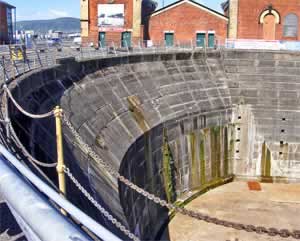 Titanic Dock, the largest dry dock in the world Photo rebekah.grmela |
|||||||
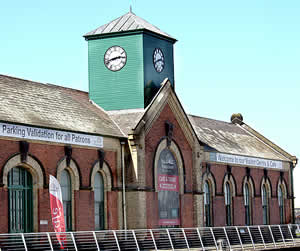 The Pump-House, which drained the dock and is now a shipbuilding heritage centre, with rare footage of Titanic Photo ardfern |
|||||||
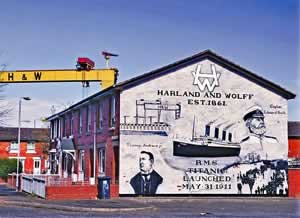 Titanic Mural. Photo Northen Ireland Tourist Board |
|||||||
|
|||||||
|
|||||||
Belfast Tourist Information Centre, 47 Donegall Place, BT1 5AD. Tel: 028 9024 6609 |
|||||||
Titanic Dock and Pumphouse is open daily, 10am to 5pm. Entry costs around £5 for adults, £3 children. Northern Ireland Science Park, Queen's Road, Titanic Quarter, Belfast, BT3 9DT. Tel: 028 9073 7813 |
|||||||
You can take a Guided Walking Tours of the Titanic Quarter, including the Drawing Offices where Titanic was designed, and Titanic’s Dock and Pump-House, where her superstructure was fitted out. The Walking Tour meets outside the Premier Inn Hotel, Titanic Quarter at 11am & 2pm daily. Tel: 07546 489875 |
|||||||
The Titanic Belfast Visitor Attraction, is open daily from April 2012, 9am to 7pm (10am to 5pm on Sunday's). Tickets cost around £14 for adults, children £7. Booking essential at either the Belfast Tourist Information Centre (see above) or telephone: 02890 766399. Titanic House, 6 Queen's Road, Belfast, BT3 9DT. |
|||||||
The Lagan Boat Company offer Titanic Boat Tours called "She was alright when she left here!!". Boats leave daily from the Big Fish at 12.30pm, 2pm and 3.30pm, April to September (plus limited tours in winter). Tickets cost around £10 for adults, £8 children. Tel: 028 9033 0844 |
|||||||
|
Pocket Britain is optimised for use on a smartphone or tablet with internet access. All content is subject to copyright. All reasonable methods have been used to ensure information supplied is accurate at the time of publication. However, it is advisable to check information before relying on it. Privacy Policy |